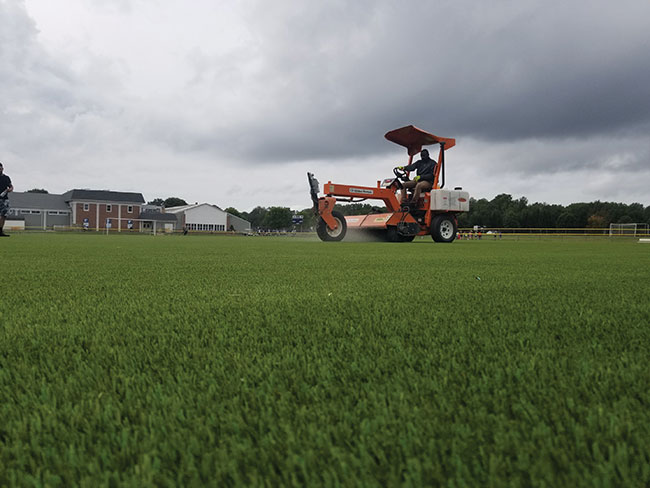
Features
Sports turf
Turf Care Equipment
Properly care for artificial turf fields
Synthetic turf is not maintenance-free, and here’s how to care for it
June 14, 2021 By Paul Adams
 Synthetic turf fields are not maintenance-free and require ongoing attention to ensure their safety and playability. Photo courtesy Elite Turf USA
Synthetic turf fields are not maintenance-free and require ongoing attention to ensure their safety and playability. Photo courtesy Elite Turf USA As the spring and summer sports seasons start back up and turf fields begin to see more activity, it is important that facility managers are maintaining the care of their synthetic turf fields.
Follow these simple suggestions from Elite Turf USA, a leading synthetic turf provider, on how to properly maintain the health and durability of your turf field and significantly extend its life and performance.
Keep your turf as clean as possible
To effectively protect synthetic turf fields, it is important to keep them clean. The first step is to follow these maintenance suggestions to preserve its surface:
- Control access to the field to minimize mud/dirt tracking on field
- Keep the surface free of litter, mud, and debris
- Provide ample garbage and recycling receptacles
- Post signs prohibiting smoking and carrying food or drink onto the field
- Properly monitor the use of motorized vehicles on the field
- Discourage the use of chewing tobacco, gum, and sunflower seeds
- Monitor field for damage and repair promptly
- Follow suggested maintenance and cleaning procedures provided by your turf supplier
Make sure to water your synthetic turf
No, synthetic turf is not alive, however, it still requires hydration in order to cool down before evaporation takes place. For turf fields that are outside, rain is the best cleanser as it gently cleans the fibres of dust, pollen, and airborne particles in a way that is difficult to duplicate manually. For indoor fields or fields that may be in areas where rainfall is scarce, an occasional watering is beneficial to cleanse the synthetic surface.
Remove all litter, debris, and even the particles you cannot see
Daily care is truly ongoing care. The amount of activity the turf receives will determine the amount of upkeep that is needed. For light trash (paper, peanut shells, sunflower seeds, athletic tape, etc.) and airborne dust, you can easily remove them through various instruments. For non-infilled systems, trash can be removed easily with a lawn sweeper, maintenance sweeper, or a motorized vacuum. For infilled systems, the best tool to clean the field is a shop vacuum, and be sure to angle the hose so the infilled material does not get vacuumed along with the debris. Vacuum cleaners are not recommended to remove mud.
The use of maintenance machines
Keeping up with the maintenance of synthetic turf may require the use of various tools and machines. There are several points to keep in mind when using equipment:
Sweepers. The sweepers of your machines should have synthetic fibre bristles such as nylon or polypropylene. Double check the brush does not contain any metal or wire as metal fibres can become loose and cause injuries to players, and can damage the surface of the field. The length of the brush should be a minimum length of 2.5 inches and maximum 0.030 inches.
Brushes. For best results, the brush should be set so that it barely is touching the tips of the turf’s fibres. If the brush is set too low and is digging into the turf fibre pile or backing, it can damage the turf. The brush setting is different, depending on the model and type of sweeper, and should be monitored frequently.
Temperature limitations. Never use a motorized vacuum sweeper during the heat of the day if the ambient temperature exceeds 90 degrees Fahrenheit.
Weight limitations. Any sweepers that weigh more than 300 pounds should have pneumatic tires with a maximum tire pressure of 35 pounds per square inch. Do not park vehicles on the turf, especially in peak hours of the day when heat is greater or when turf is wet for long periods of time.
Exhaust fumes. When operating machinery on indoor turf fields, we recommend using electric or propane-powered equipment. For outdoor fields, the type of fuel or power used is not as important, however, if the machine has an internal combustion engine, make certain that the hot engine exhaust is not discharged down towards the playing surface. Ensure that the sweeper is designed in such a way that the hot muffler or exhaust pipe cannot drop directly onto the surface.
Spillage. Make sure that while sweeping, there is no dripping, leaking, or spilling of lubricating oil, grease, transmission fluids, etc. on the turf’s surface. Spills of such liquids can discolour the turf and damage the fibres and backing. Do not change or add fluids to maintenance equipment while on the field.
How frequently should you clean your turf?
You may ask, how often should I be performing these maintenance tasks? The frequency depends on the quality and use of your turf field. The removal of loose rubbish and surface dust should be performed on an as-needed basis, however, generally we suggest conducting maintenance about once a week, depending on the usage of your field.
Your field will perform, look, and feel better for an extended period of time if you follow set maintenance protocols.
Paul Adams is vice-president of sales and marketing for Elite Turf USA.
Print this page